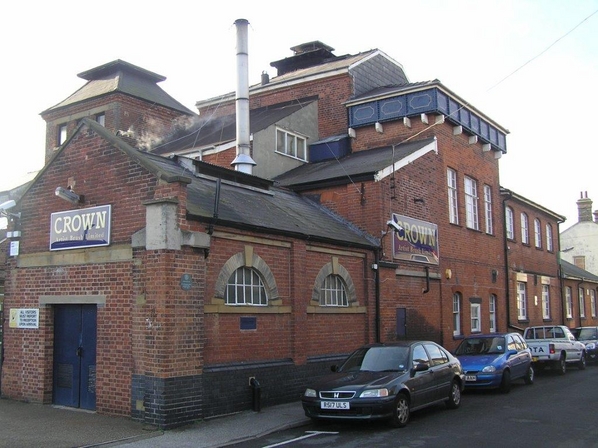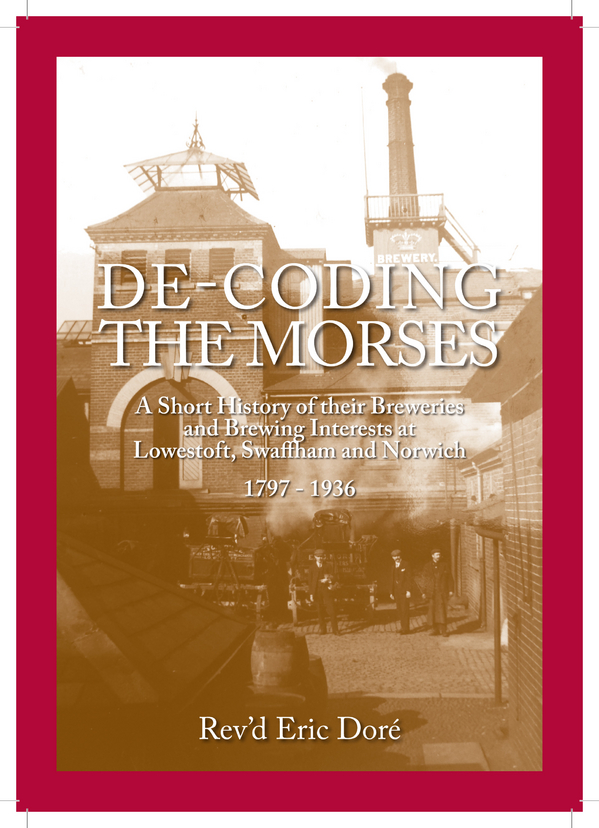Morse and beer: solving an old 'cold case'
Added: Saturday, November 28th 2015

It’s fitting to describe Eric Doré’s book De-Coding the Morses as a brilliant piece of detective work as there’s a powerful link between the Morse breweries in East Anglia and the fictional chief inspector of the same name.
In addition, Sir Jeremy Morse, a descendant of the brewing family and former chairman of Lloyds Bank, is a devoted compiler of cryptic crosswords and Colin Dexter, another crossword devotee, took the banker’s name when he created his detective. To add a further touch of spice to the story, Inspector Morse and his creator are both lovers of good ale while one of the founders of the main brewery in Lowestoft was Edgar or E Morse. We discovered on his deathbed that Inspector Morse’s first name was E for Endeavour. But devilish though he is at scattering clues, I doubt Colin Dexter was aware of the brewing connection.
The Morse breweries in Lowestoft, Norwich and Swaffham operated from the 18th to the 20th centuries, their activities halted by the ceaseless wave of takeovers and mergers that snuffed out so many old family beer makers. Most of them have disappeared from view, not even meriting a footnote in brewery history books, and we are indebted to Eric Doré for his dedicated work in piecing together the Morse story.
Eric is a beer lover from Sussex who retired to Suffolk where he wrote a history of Lacons when the Great Yarmouth brewery, bought and closed by Whitbread in the 1960s, re-opened two years ago.
He was visiting the Crown Artist Brush Company’s factory in Crown Street when it struck him that the design of the brownstone buildings, with a pagoda roof, tall chimney and exterior water tank, was similar to many 19th century breweries. He quickly discovered that it was the site of the Crown Brewery, operated by the Morse family from 1842 until 1936, when it was bought by Morgans of Norwich, which later fell victim to Watneys when the London brewer went on the rampage in Norfolk.
The Crown Brewery had been founded in 1842 by Frederick Morse who went into partnership two years later with Henry Woods. From 1895 the brewery was run by Frederick’s sons Edgar and Gilbert under the name of E & G Morse, which brings the enigmatic E Morse into the picture. The site had first been used a china factory and then a malt house before brewing began.
Beer making developed at a pace in order to meet the demands of workers engaged in agriculture and fishing. Many of the beers were prodigiously strong, including a 10%-plus XXXX and a 9% XXX. Mild Ale weighed in at 6% and even Table Beer, designed to drunk by families with their meals, was around 3.6%. A Fishing Beer was a more moderate 3.2% -- presumably captains of fishing boats were anxious their crews should not imbibe too deeply and fall overboard.
There were no such inhibitions about supplying strong liquor to those on land. A generous amount of XXX was donated to Christmas meals at the local workhouse or poorhouse where the inmates washed down meals of dumplings, roast beef and plum pudding with lashings of ale.

The Crown Brewery rapidly grew into a major business in the area, employing a large number of brewers, maltsters and coopers. It also built a sizeable estate of pubs. In 1832 it added to the estate by buying 13 pubs from a Beccles brewery for £6,330 – half a million in today’s money.
In the mid-1870s the expansion of the brewery was measured by a decision to buy a large maltings in Ipswich, which had become the major malting town in the region. The Crown Brewery had concentrated at first on strong brown beers brewed primarily with amber malt. But it’s likely the Ipswich maltings were able to produce modern pale malt as the beers produced in Lowestoft reflected changes to both brewing practice and consumer preference with the addition of Pale Bitter Beer and Light Dinner Ale.
Morse and Woods spread their wings. They bought and ran the Swaffham Brewery in the town of that name from 1861 until 1895. Unlike Lowestoft, the Swaffham site was later demolished, with little trace of it left today. The brewery was run for some years by Arthur Morse, son of John Morse, who became a figure of some repute in the town. He won praise for a paper written in 1841 attacking the Corn Laws, defending the rights of the poor and agricultural workers while attacking farmers and landowners. Deaths in the family and serious damage to the brewery in a great storm in 1895 prompted the sale of the Swaffham operation to the big Norwich brewery of Steward & Patteson. Brewing ceased at Swaffham in the 1920s, though the brewery maltings continued for some after that. The only known beer brewed at Swaffham during the period of Morse’s ownership was a strong Old Ale.
The Morse family was heavily involved in brewing in Norwich from 1797 when John Morse bought the brewery and pubs previously owned by the Day family. It was the biggest brewery in the city and enjoyed a fine reputation for its porter. The company flourished under John Morse, who became a significant figure in the community. A plaque erected at his large house at All Saints Green states: “John Morse, 1745-1837, Sheriff of Norwich 1799, Mayor 1781 & 1803, He was a brewer of porter in the parish of St Martin’s at Oak.”
When John Morse retired in 1829, the company passed to his son George, a former army officer who seemed keener on becoming a country squire than running a brewery. In a fateful move, the Oak Street Brewery merged with Steward & Patteson. S&P was keen to acquire Morse’s pubs (plus ça change!) and put the brewery up for sale just one week after the merger was arranged.
An advertisement shows the Morse plant was a substantial one with a copper capable of boiling 80 barrels, a patent refrigerator that shows it was using modern techniques for cooling, two square fermenters each holding 120 barrels of beer and seven storage vats varying in size from 110 to 230 barrels, presumably to age porter. In spite of the size and viability of the brewery, the buildings were converted into residential homes.
The Morse family played an active role in Steward & Patteson. Arthur Francis Morse served as chairman of the company while George Henry Morse was a pillar of the community serving first as mayor of Norwich and later Lord Mayor. He was knighted for his efforts. Eric Doré believes younger members of the Morse family, who were major shareholders in S&P, were hostile to the takeover of the company by the London brewer Watney Mann in 1963 but S&P was a limited company and the majority of shareholders swallowed the Watney bait.
Brewing had continued in Lowestoft, with the site extended in the 1920s to cope with demands for the beer with a range that included Dark Lunch, Full Brown, Light Bitter, Strong Ale, Crown Stout and Extra Stout. But nemesis beckoned. The economic recessions and depressions of the 1920s and 30s, with appalling levels of unemployment and poverty, put a terrible strain on the brewing industry and in 1936 the Crown Brewery was merged with the large Norwich brewery of Morgans. What followed was all too familiar: Morgans closed the Lowestoft brewery and concentrated on putting its own beers into Morse pubs.
Morgans in turn had its comeuppance. In the 1960s, along with its Norwich rivals Bullards and Steward & Patteson, it was bought by Watney Mann and eventually closed.
Thanks to Eric Doré painstaking research, the Morse story is not lost – and neither are the beers. For the launch of the book in Southwold, Adnams recreated two of the Morse beers brewed in Lowestoft, where Eric had discovered old recipes. The beers were a 2.3% Table Beer and 4.3% Mild Ale. Table Beer made up 22% of Morse’s production in the 19th century and its low strength meant it could be consumed by all members of a family as they enjoyed their lunch or dinner. Intriguingly, both beers were made with Diastatic Amber Malt, with no pale malt used. Diastatic means the grain contains a sufficient level of enzymes to convert starch into malt sugar. While amber malt is still made in Britain it’s merely coloured malt today and the brewers at Adnams had to get special supplies from Belgium.
The beers were made strictly for the book launch and are not commercially available. Copies of the book can be obtained via PayPal for UK residents: paypal.me/ericdore/10 at a cost of £10, including £2 postage. Non UK residents should email [email protected]. The book can also be bought direct from the author: Eric Dore, 86a Southwold Road, Wrentham, Beccles, Suffolk NR34 7J. Cheques for £10 should be made out to Eric Dore.





